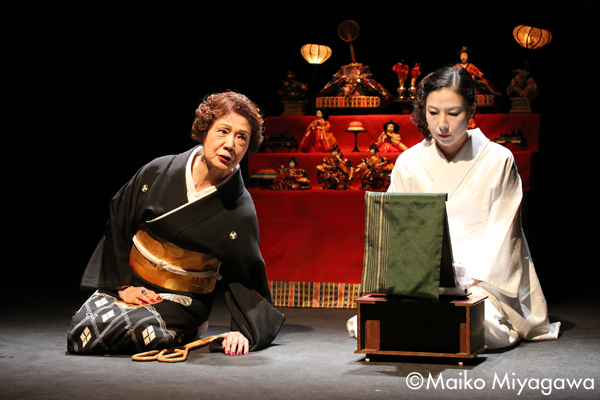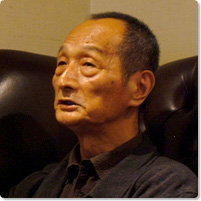Scene 1. A woman ‘Woman 1) is singing the song “Ano Ko wa Dare, Dare desho-ne” as she arranges a set of old Girls Festival dolls on the tiered doll stand. A man of semi-gangster looking (Man 1) who appears to be the master of the house comes home from collecting debt payments to find this unknown woman who apparently has let herself into the house unannounced. She tells him she is “Sanchome no Miyoko” (Miyoko from 3rd Street).
From this day on, Miyoko and her adopted son (Man 2) work their way into Man 1’s family with devastating results. There are plans in motion to have Man 1’s two granddaughters marry Miyoko’s two adopted sons, and the same time Miyoko is planning to make them legally her adopted daughters. Now we find Man 1’s son (Man 3) tied up and Miyoko’s adopted son Man 2 with a kitchen knife in his hand saying that the old woman Man 1 lives with (presumably his wife) is dead.
Scene 2. Most of the Girls Festival dolls have been put away. Using her skill with words and lies when necessary, Miyoko is succeeding in taking control of the Man 1’s family, hiding the fact of the old wife’s death and proceeding with the plans for the marriage of the two granddaughters; and by now she is living in the house unchallenged. Also, with no one’s knowledge, she has gone to the company where Man 1’s the son, Man 3, works and filed his resignation, surely with the intention of getting his retirement money.
Then the family is told [by Miyoko] that the son, Man 3, was found to have been illegally using the company’s money, fired from the company and then committed suicide by jumping from the roof of a building.
Scene 3. Sitting on straw mats eating lunch, three women from the neighborhood (Woman 5, Woman 6 and Woman 7) are chapping. It is unclear whether it is fact or fantasy, but they are talking about the means they used/would use to kill their husbands.
Scene 4. Man 1, accompanied by his daughter, Woman 4, is pushing a cart carrying a coffin with his son’s body in it on the way to the crematorium. It seems that Miyoko has thrown the family into confusion by taking all matters into her own hands, doing things like suddenly changing the crematorium they will use and deciding by herself who will represent the family as the chief mourner of the funeral. Also, no one knows what has happened to the retirement money resulting from the son’s resignation that she filed by herself without anyone’s consent. Man 1 and his granddaughter, Woman 4 are dumbfounded and stand in shock when they hear that Miyoko has claimed that Woman 4 has stolen the retirement money and had the police post a wanted person bulletin.
Scene 5. In front of the Girls Festival doll stand, Miyoko is threatening the granddaughter, Woman 3, who is in her wedding dress, apparently having run away from her wedding at the last moment. As Miyoko presses her asking where she is trying to run away to, the fact is revealed that Man 1 has been sending women to work as prostitutes at the brothel known as Yokohama’s Kotobuki Inn. Also, it is revealed that in the past, the granddaughter Woman 2 became pregnant at Kotobuki Inn with the child of Miyoko’s adopted son, Man 2, whose was engaged to marry her sister, Woman 3. Despite the revelations, Miyoko is determined to go through with the wedding, but after a distraction when a local patrolman comes around to the house seeking possible information about a series killings of cats that has occurred in the neighborhood, they find Woman 3 dead in the bath room, having hung herself.
Scene 6. Man 1 is now caring for the baby that Man 2 (Miyoko’s adopted son) left in his care before he ran away. His granddaughter, Woman 2, has fallen from a bridge and died.
Two neighborhood women (Woman 6 and Woman 7) are recalling an incident during the Girls Festival long ago where a man had raped a woman who had snuck into his house in front of the doll stand.
Miyoko confesses that long ago, when she snuck into a house and saw a mother and two small daughters in front of the Girls Festival doll stand, she got the idea that if she could work her way into that family she could become “Miyoko,” so she got on good terms with the mother and later killed her.
However, when the fact was revealed that the same Girls Festival dolls had been lent back and forth between two houses every three years, the possibility emerged that Miyoko had worked her way into the wrong family.
To a young Woman 4 who as run away from the Kotobuki Inn brothel, Man 1 informs her that Miyoko has committed suicide in jail, after which the two part. Man 1 is left standing alone in the wind in front of the baby carriage of the child he is caring for.



